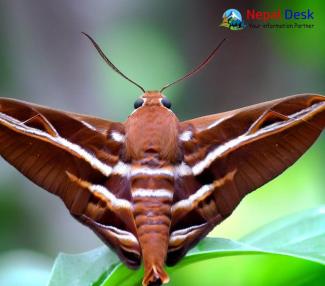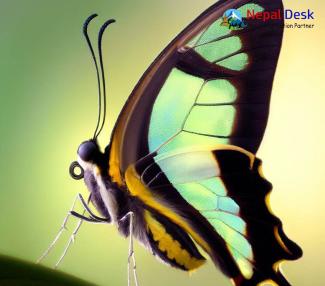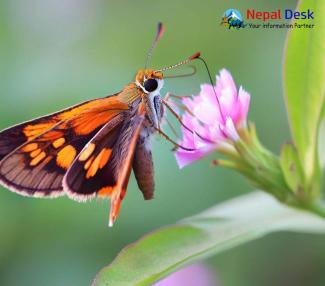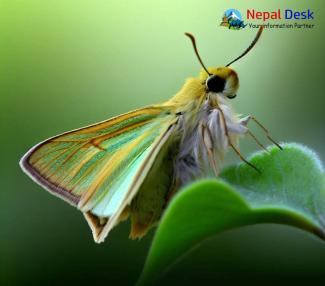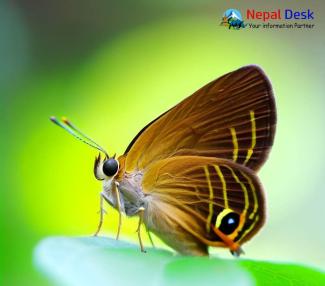
Hesperiidae, known as skippers, are a family of small to medium-sized butterflies comprising over 3,500 identified species globally. Skippers are characterized by their fast, darting flight patterns and the ability of their caterpillars to make leaf shelters. They display a range of biological differences from other butterfly families.
1.2 Importance in Butterfly Diversity
With over one-fifth of all butterfly species, skippers substantially contribute to total butterfly diversity worldwide. Understanding skipper ecology and evolution provides insights into broader patterns of butterfly adaptation and speciation. As major pollinators and a food source for other wildlife, skippers play key functional roles in many ecosystems.
1.3 Skippers in Nepal's Biodiversity
While Nepal has incredible biodiversity, documentation on its butterflies has been limited, especially complex groups like skippers. Recent surveys found over 550 butterfly species in Nepal, but further work is needed on distribution and ecology of Himalayan skippers. Many reside in sensitive high-altitude meadows. Improving skipper documentation will support Nepal conservation and global knowledge of this influential insect family.
Taxonomy and Classification
Global Taxonomic Overview
Globally, Hesperiidae taxonomy divides skippers into several subfamilies, including Pyrginae, Heteropterinae, Hesperiinae, and Trapezitinae. These subfamilies can be further divided into tribes and genera based on morphological traits, geographic distributions, and genetic evidence. For example, the tribe Baorini, part of the subfamily Hesperiinae, includes many skipper species endemic to the Himalayan region. Recent phylogenetic studies have improved understanding of evolutionary relationships among skipper genera and species, though taxonomic changes still occur.
2.2 Species of Hesperiidae in Nepal
Documented Hesperiidae in Nepal include species from tribes such as Baorini and Taractrocerini in the subfamily Hesperiinae as well as some Trapezitinae species. Baorini skippers such as the Himalayan swift and Ogata's ace are high-altitude specialists only found in the Himalayas. Other Nepalese skippers have more widespread Asian distributions, like the Indian skipper. In total, over 90 Hesperiidae species have been recorded in Nepal so far. However, additional species likely occur, especially in remote northern regions and high-altitude zones which have been less extensively surveyed. DNA barcoding and ongoing taxonomic work on Asian skippers will help clarify Nepal's true species richness going forward.
Physical Characteristics of Skippers
General Description
Skippers display a range of characteristic physical traits compared to other butterflies. They have stout, hairy bodies and short antennae with hooked or angled tips. Their wings are more angular and pointed compared to the rounded wings of other groups. Skipper flight is quick and darting. Many species hold their forewings partly open when resting. Skipper caterpillars build distinctive leaf shelters by folding or rolling leaves using silk.
3.2 Traits of Nepalese Species
Himalayan skipper species found in Nepal exhibit adaptations to high-altitude environments. For example, many have thicker, more insulative body hair and wings with longer scales compared to lowland tropical skippers. This provides warmth during cooler mountain conditions. Their wings may be darker to absorb more solar radiation. Caterpillars of some Nepalese skippers, like the Himalayan Swift, construct especially durable leaf shelters able to withstand monsoon rains. DNA evidence suggests Nepalese species evolved a diverse array of mechanisms to persist in challenging high-altitude environments absent in their lowland relatives. Further study of endemic species like Ogata's ace can provide insights into high-altitude adaption in skippers more broadly.
Behavior and Adaptations
Flight and Feeding Patterns
Skippers exhibit characteristic flight and feeding behaviors. Their rapid, darting flight allows quick nectar feeding on flowers. In some species, males establish and patrol mating territories waiting for females. Most adult skippers have short lifespans of 1-2 weeks focused on breeding. Larval caterpillars often exhibit complex social behavior, building communal shelters. Caterpillars avoid predators by rapidly wriggling backward when disturbed.
4.2 Adaptations in Nepal's Climates
Himalayan skipper species in Nepal display adaptations allowing survival in challenging mountain conditions. Cold winters and monsoon storms pose threats, so summer emergence times are often synchronized. Small hairy bodies reduce heat loss, while dark wing pigments absorb heat. Some species extend proboscides to access deeply hidden nectar sources. Short adult lifecycles ensure mating and egg laying within small activity windows. Caterpillar shelters provide protection from heavy rains and cold, stabilized with durable, water-resistant silk. DNA analysis indicates strong natural selection for adaptations allowing persistence through harsh winters or extreme weather events. Further study of mechanism such as diapause overwintering can illuminate climate change resilience.
Habitats in Nepal
5.1 Geographic Distribution
Nepalese skippers are found across much of the country but reach peak diversity in central and eastern mountain regions. The Kali Gandaki river valley and areas around Mt. Everest host many Himalayan endemics. Western regions tend to have more widespread South Asian species. Documentation is still limited in remote Far West mountain areas.
5.2 Habitats and Altitudinal Range
Skippers occupy a wide altitudinal range from lowland grasslands up to 5,000+ meters in specialized high alpine meadows. Different species concentrate in flowering meadows, forest openings, riparian vegetation along streams, and agricultural cropland. The highest diversity occurs in uncultivated mountain meadows and grassy rangelands from 2,500-4,000 meter elevations.
5.3 National Parks and Conservation Areas
Many Nepal skippers are found in protected areas like Langtang, Sagarmatha, and Makalu-Barun National Parks. Other key sites include Annapurna Conservation Area and Kanchenjunga Conservation Area. These reserves conserve sensitive high meadow habitats by limiting grazing and agricultural conversion. Continued protection of parks and community forest areas supports skipper population strongholds. More surveys are needed in remote protected areas to fully document resident species.
Life Cycle and Reproduction
Development Stages
Like other butterflies, Nepalese skippers undergo a complete metamorphosis with distinct egg, larva, pupa, and adult stages. Eggs are laid singly or in clusters on host plants. Larval caterpillars build protective shelters by folding leaves, emerging to feed. Most species overwinter as pupae, with adults emerging the following summer. Some may take 2-3 years to complete development at high altitudes. Adults live 1-2 weeks focused on breeding and nectar feeding.
6.2 Host Plants in Nepal
Documented larval host plants used by Himalayan skipper species include grasses such as Phacelurus and Agrostis as well as sedges like Carex and Kobresia that are common high altitude meadow genera. Bamboo is also used by some species. Woodland skippers utilize trees and shrubs including oak and rhododendron. Preferred hosts of many skipper species found in remote northern areas remain unstudied. Continued documentation of caterpillar host plants and habitat associations will support conservation of specialized endemic species.
Skippers in Nepalese Culture and Tourism
Cultural Significance
Butterflies including skippers have held cultural importance in Nepal and the broader Himalayan region since ancient times. Native languages have rich vocabularies describing butterflies, indicating their familiar presence in daily life. Folk stories feature symbolic butterfly themes about transformation or fleeting beauty. Some tribes have used butterfly wing decorations in spiritual costumes and rituals. More recently, butterflies have emerged as symbols of environmental conservation in Nepal.
7.2 Butterfly Watching as a Tourist Attraction
In recent decades, Nepal has rapidly grown as a global hotspot for butterfly eco-tourism. Tour companies offer specialized butterfly watching tours to famous regions like Annapurna or Mt. Everest Base Camp during peak summer emergence. Such tours provide significant income to local communities. Photographing colorful endemic species like the purple highland hairstreak has become a quintessential part of visitors' Himalayan trekking experiences. Several travel guides have been published detailing prime butterfly watching sites across Nepal.
7.3 Famous Regions for Butterfly Watching
Hotspots for observing skippers and butterflies include Annapurna Conservation Area and other protected areas with wildflower-filled meadows from 3,000-4,000 meter elevations. The subtropical forests surrounding Chitwan and Bardia National Parks also host incredible tropical butterfly diversity. Agricultural areas like Pokhara and valley regions near Kathmandu likewise provide abundant nectar sources that concentrate butterflies. As Nepal's reputation for superb butterfly watching spreads globally, conservation of skipper habitats and expansion of community-led tours will remain a priority.
Conservation Status in Nepal
Environmental Threats
Nepal’s skippers face threats from habitat loss and climate change. Conversion of mountain meadows and grasslands to agriculture removes critical breeding areas. Overgrazing by livestock also degrades habitats. Climate warming allows tree and shrub expansion into formerly open habitats. Increased variability in monsoons and winter weather could disrupt delicate life cycles.
8.2 Conservation Efforts
Several Himalayan skipper species are protected under CITES regulations on commercial trade. Nepal has expanded its national park system to help protect high altitude meadows. Public education campaigns feature butterflies as symbols to promote conservation ethics. Recent IUCN Red List assessments found the majority of evaluated Nepalese skippers are currently Least Concern, but some rare endemic species are Near Threatened or Data Deficient. More assessments are needed.
8.3 Tourism and Conservation Awareness
Butterfly eco-tourism helps fund protected area management and raises international visibility of conservation needs. Tourist demand to see spectacular endemic species like the Lilac silverline provides economic incentives for communities to monitor habitats. Traveler awareness of threats like climate change also boosts pressure for global action. As global skipper aficionados are attracted to Nepal's superb biodiversity, conservation frameworks must ensure sustainable habitat protection.
Practical Information for Tourists
Best Times and Locations for Watching
The peak summer months of June-August provide the best skipper viewing when monsoon rains trigger emergence and flowering. Prime trekking areas like Annapurna, Everest region, and Langtang host superb alpine species diversity. Lowland national parks like Chitwan and Bardia offer tropical species. Cultural sites like Kathmandu Valley and Pokhara Valley farmlands also abound with butterflies taking nutrients from crops.
9.2 Guided Tours and Programs
Reputable eco-tour companies like Nepal Sanctuary Treks, Royal Mountain Travel, and Nature Treks offer specialized butterfly watching tours guided by expert naturalists. These tours target prime habitats during peak diversity. Some non-profits like Bird Conservation Nepal also train Himalayan communities to lead butterfly monitoring and tours.
9.3 Responsible Watching Tips
Tourists should take care to not damage sensitive habitats by staying on trails. Do not handle or collect butterflies. Bright clothing helps avoid accidental disturbances. Use binoculars instead of getting too close. Understanding indicators of stress behaviors in different species can help improve responsible observation. Volunteering with scientist-led monitoring projects also provides memorable learning experiences while contributing to conservation data collection.
Conclusion
Skippers in Nepal’s Ecosystem
Skippers fill vital ecological roles in Nepal as pollinators and prey species, indicating the health of montane habitats. Their sensitivity to climate and land use changes make them important biodiversity indicators. Preserving endemic skippers protects broader Himalayan ecosystem integrity.
10.2 Promoting Sustainable Tourism
Growing global interest in Nepalese skippers for ecotourism requires ensuring tourist revenue sustains communities and conservation. Responsible butterfly watching guidelines minimize environmental harm and disruption. Supporting local guiding enterprises retains benefits locally.
10.3 The Beauty and Diversity of Skippers in Nepal
From vibrant Apollo skippers shimmering amidst Everest meadows to tiny gnats darting along forest streams, Nepal’s Hesperiidae display astonishing beauty and adaptability. Conducting further surveys and monitoring to conserve this global hotspot of skipper abundance and endemism remains an essential priority for both nature enthusiasts and conservation scientists alike.

